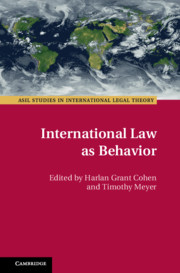Book contents
- International Law As Behavior
- ASIL Studies in International Legal Theory
- International Law As Behavior
- Copyright page
- Dedication
- Contents
- Tables
- Contributors
- Acknowledgments
- 1 International Law As Behavior
- 2 Deadlines As Behavior in Diplomacy and International Law
- 3 Cooperating without Sanctions
- 4 Egocentric Bias in Perceptions of Customary International Law
- 5 Explaining the Practical Purchase of Soft Law
- 6 Toward an Anthropology of International Law
- 7 Transnational Collaborations in Transitional Justice
- 8 Advancing Neuroscience in International Law
- 9 The Missing Persons of International Law Scholarship
- 10 The Wrong Way to Weigh Rights
- Index
5 - Explaining the Practical Purchase of Soft Law
Competing and Complementary Behavior Hypotheses*
Published online by Cambridge University Press: 15 March 2021
- International Law As Behavior
- ASIL Studies in International Legal Theory
- International Law As Behavior
- Copyright page
- Dedication
- Contents
- Tables
- Contributors
- Acknowledgments
- 1 International Law As Behavior
- 2 Deadlines As Behavior in Diplomacy and International Law
- 3 Cooperating without Sanctions
- 4 Egocentric Bias in Perceptions of Customary International Law
- 5 Explaining the Practical Purchase of Soft Law
- 6 Toward an Anthropology of International Law
- 7 Transnational Collaborations in Transitional Justice
- 8 Advancing Neuroscience in International Law
- 9 The Missing Persons of International Law Scholarship
- 10 The Wrong Way to Weigh Rights
- Index
Summary
Why do international and domestic legal actors employ and even apply international soft law sources, although these sources are not legally binding? In this chapter, after surveying different ways in which soft law is employed and applied in international and domestic courts, we offer several rational choice and behavioral hypotheses regarding the influence of soft law. These hypotheses are examined in relation to different types of soft law instruments and different actors who apply and create soft law. We conclude with a brief discussion of the dialectic relationship between soft law making and the influence of soft law.
- Type
- Chapter
- Information
- International Law as Behavior , pp. 98 - 127Publisher: Cambridge University PressPrint publication year: 2021
- 3
- Cited by

